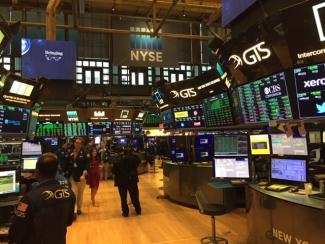
Market Watch - July 2019
Written by Rick Welch
We are pleased to provide you with our quarterly newsletter featuring the status of our investment class weightings, our interpretation of recent data and our outlook for the future. If you have any questions about any topic, we hope you will not hesitate to contact us.
Status of our Investment Class Weightings
Changes from our April 2019 Market Watch are noted in italic.
US Large Cap Sectors –
Overweight –
Neutral – Communication Services, Consumer Discretionary, Consumer Staples, Health Care (↓), Industrial, Information Technology and Materials
Underweight – Energy and Financials
No Weighting – Utilities
For the first time in five years, we have no sector which we rate as overweight.
US Mid and Small Cap – Maintain all weightings.
International Developed Markets – Maintain all weightings.
Emerging Markets – Maintain all weightings.
Alternative Strategies – Maintain all weightings.
We will maintain an average bond portfolio duration of approximately 5.73 years, the current effective duration of the Barclays US Aggregate Bond Index.
Multi-sector Bond Funds – Maintain all weightings.
Investment Grade US Corporate Bonds – Maintain all weightings.
Convertible Bonds – Maintain all weightings.
High Yield US Corporate Bonds – Maintain all weightings.
Investment Grade Municipal Bonds – Maintain all weightings.
Data – During Q2, equity markets both here and abroad remained volatile with gains in both April and June surrounding losses in May. For 2019, we see the following benchmark returns: US Large Cap – DJIA (+14.02%) and S&P 500 (+17.34%), US Small Cap - Russell 2000 (+16.16%) and International - ACWX (+11.43%). Economic data during Q2 was generally mixed, with many data points showing the stress associated with the multi-front trade war now underway between the US and many of its trading partners. Expectations for US corporate earnings growth have softened. GDP, the broadest measure of economic output, for Q1 showed an annualized growth rate of +3.1%, which followed slower growth in Q4 (+2.2%). Current forecasts for Q2 GDP growth range from +1.0% to 1.6%. Volatility (as measured by VIX) rose throughout the quarter, peaking at 23.28 on May 9th, and finished at 15.08, below the long run average of 20.0. The Conference Board in reporting the May LEI (Leading Economic Index) said that “positive contributions from financial conditions and consumers’ outlook offset the weakness in stock prices and the manufacturing sector. While the economic expansion is now entering its eleventh year, the longest in US history, the LEI clearly points to a moderation in growth towards 2 percent by year end.” During the quarter, the yield on the benchmark 10-year US Treasury dropped from 2.41% to 2.00%. Monthly job growth in 2019 has averaged 164,000 (compared to 223,000 in 2018) and in May the national unemployment rate remained at 3.6%, a 50-year low. New weekly unemployment claims remained low, averaging 215,538 in Q2, compared to 223,923 in Q1. Consumer confidence, as measured and reported by the Conference Board, showed a sharp decline in May as a result “of the escalation in trade and tariff tensions. Although the index remains at a high level, continued uncertainty could result in further volatility and, at some point, could even begin to diminish consumers’ confidence in the expansion.” The June Manufacturing Outlook survey (Philadelphia Fed) reported that “indicators for new orders, shipments and employment remained positive but declined from their May readings. Most of the survey’s future activity indexes improved but continue to reflect muted optimism for the remainder of the year.” Inflation, as measured by the change in the Consumer Price Index, came in at 1.8% in May and remained below the Fed target of 2%. Sluggish and volatile data in housing starts and new home sales combined with waning homebuilder sentiment will continue to impact the housing sector.
Outlook – At its June 18/19 meeting, the Federal Open Market Committee (FOMC) left its policy rate unchanged in a range between 2.25% and 2.5% and in its statement highlighted “that uncertainties about the economic outlook have increased. The statement no longer included the language that supported a patient approach to policy; rather the FOMC will monitor the implications of incoming information and will act as appropriate to sustain the expansion, with a strong labor market and inflation near its symmetric 2% objective.” The statement included a “downgrading of their assessment of economic activity to a moderate pace from solid and noted that the growth of household spending appears to have picked up, that indicators of business investment have been soft and that market-based measures of inflation consumption have declined.” In his press conference, Fed Chairman Jerome Powell said that “my colleagues and I have one overarching goal, to sustain the economic expansion. He noted that apparent progress on trade talks had turned to greater uncertainty and that many Fed officials now see the case for somewhat more accommodative policy to have strengthened.” For the first time in his tenure as Chairman, the FOMC vote was not unanimous with 8 votes for no policy change, 8 votes for a reduction (probably 25 bps) by the end of 2019 and 1 vote for a rate hike.
The financial markets appeared to welcome this new commitment to more accommodative policy in the face of the ongoing trade war as the immediate market response was positive. The markets are expecting a lot from the Fed over the remainder of 2019 as the federal-funds futures market is currently pricing in three 25 bps reductions in the central bank’s target, from the current 2.25% to 2.50% range with an overwhelming 85% probability of a cut at the July 30-31 FOMC meeting. These expectations present a tall order for the Fed. While we believe the case is strong for 1 rate cut this year, we caution that the market may be pricing in more aggressive policy easing than is likely to happen – this could lead to investor disappointment later this fall. Notwithstanding, we note that absent the contractionary forces on trade that a US economy growing at its long-term trend, with a strong labor market and muted inflation would not normally suggest that monetary policy accommodation was indeed necessary. Furthermore, we question just how much can reductions in already low interest rates do to offset weakness which may result from a more protracted trade war with China.

